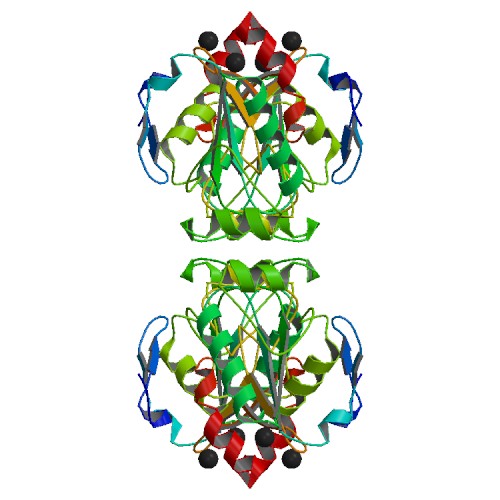GPX2 (gene)
| Glutathione peroxidase 2 (gastrointestinal) | |||||||||||||
|---|---|---|---|---|---|---|---|---|---|---|---|---|---|
 PDB rendering based on 2he3. | |||||||||||||
| |||||||||||||
| Identifiers | |||||||||||||
| Symbols | GPX2 ; GI-GPx; GPRP; GSHPX-GI; GSHPx-2 | ||||||||||||
| External IDs | Template:OMIM5 Template:MGI HomoloGene: 20479 | ||||||||||||
| |||||||||||||
| RNA expression pattern | |||||||||||||
 | |||||||||||||
| More reference expression data | |||||||||||||
| Orthologs | |||||||||||||
| Template:GNF Ortholog box | |||||||||||||
| Species | Human | Mouse | |||||||||||
| Entrez | n/a | n/a | |||||||||||
| Ensembl | n/a | n/a | |||||||||||
| UniProt | n/a | n/a | |||||||||||
| RefSeq (mRNA) | n/a | n/a | |||||||||||
| RefSeq (protein) | n/a | n/a | |||||||||||
| Location (UCSC) | n/a | n/a | |||||||||||
| PubMed search | n/a | n/a | |||||||||||
Glutathione peroxidase 2 (gastrointestinal), also known as GPX2, is a human gene.[1]
This gene is a member of the glutathione peroxidase family and encodes a selenium-dependent glutathione peroxidase that is one of two isoenzymes responsible for the majority of the glutathione-dependent hydrogen peroxide-reducing activity in the epithelium of the gastrointestinal tract. Studies in knockout mice indicate that mRNA expression levels respond to luminal microflora, suggesting a role of the ileal glutathione peroxidases in preventing inflammation in the GI tract.[1]
References
Further reading
- Akasaka M, Mizoguchi J, Takahashi K (1990). "A human cDNA sequence of a novel glutathione peroxidase-related protein". Nucleic Acids Res. 18 (15): 4619. PMID 2388849.
- Maruyama K, Sugano S (1994). "Oligo-capping: a simple method to replace the cap structure of eukaryotic mRNAs with oligoribonucleotides". Gene. 138 (1–2): 171–4. PMID 8125298.
- Chu FF (1994). "The human glutathione peroxidase genes GPX2, GPX3, and GPX4 map to chromosomes 14, 5, and 19, respectively". Cytogenet. Cell Genet. 66 (2): 96–8. PMID 8287691.
- Chu FF, Doroshow JH, Esworthy RS (1993). "Expression, characterization, and tissue distribution of a new cellular selenium-dependent glutathione peroxidase, GSHPx-GI". J. Biol. Chem. 268 (4): 2571–6. PMID 8428933.
- Chu FF, Rohan de Silva HA, Esworthy RS; et al. (1997). "Polymorphism and chromosomal localization of the GI-form of human glutathione peroxidase (GPX2) on 14q24.1 by in situ hybridization". Genomics. 32 (2): 272–6. doi:10.1006/geno.1996.0115. PMID 8833155.
- Suzuki Y, Yoshitomo-Nakagawa K, Maruyama K; et al. (1997). "Construction and characterization of a full length-enriched and a 5'-end-enriched cDNA library". Gene. 200 (1–2): 149–56. PMID 9373149.
- Opalenik SR, Ding Q, Mallery SR, Thompson JA (1998). "Glutathione depletion associated with the HIV-1 TAT protein mediates the extracellular appearance of acidic fibroblast growth factor". Arch. Biochem. Biophys. 351 (1): 17–26. doi:10.1006/abbi.1997.0566. PMID 9501919.
- Choi J, Liu RM, Kundu RK; et al. (2000). "Molecular mechanism of decreased glutathione content in human immunodeficiency virus type 1 Tat-transgenic mice". J. Biol. Chem. 275 (5): 3693–8. PMID 10652368.
- Kelner MJ, Bagnell RD, Montoya MA, Lanham KA (2000). "Structural organization of the human gastrointestinal glutathione peroxidase (GPX2) promoter and 3'-nontranscribed region: transcriptional response to exogenous redox agents". Gene. 248 (1–2): 109–16. PMID 10806356.
- Richard MJ, Guiraud P, Didier C; et al. (2001). "Human immunodeficiency virus type 1 Tat protein impairs selenoglutathione peroxidase expression and activity by a mechanism independent of cellular selenium uptake: consequences on cellular resistance to UV-A radiation". Arch. Biochem. Biophys. 386 (2): 213–20. doi:10.1006/abbi.2000.2197. PMID 11368344.
- Komatsu H, Okayasu I, Mitomi H; et al. (2001). "Immunohistochemical detection of human gastrointestinal glutathione peroxidase in normal tissues and cultured cells with novel mouse monoclonal antibodies". J. Histochem. Cytochem. 49 (6): 759–66. PMID 11373322.
- Florian S, Wingler K, Schmehl K; et al. (2002). "Cellular and subcellular localization of gastrointestinal glutathione peroxidase in normal and malignant human intestinal tissue". Free Radic. Res. 35 (6): 655–63. PMID 11811519.
- Strausberg RL, Feingold EA, Grouse LH; et al. (2003). "Generation and initial analysis of more than 15,000 full-length human and mouse cDNA sequences". Proc. Natl. Acad. Sci. U.S.A. 99 (26): 16899–903. doi:10.1073/pnas.242603899. PMID 12477932.
- Müller C, Wingler K, Brigelius-Flohé R (2003). "3'UTRs of glutathione peroxidases differentially affect selenium-dependent mRNA stability and selenocysteine incorporation efficiency". Biol. Chem. 384 (1): 11–8. PMID 12674495.
- Esworthy RS, Binder SW, Doroshow JH, Chu FF (2003). "Microflora trigger colitis in mice deficient in selenium-dependent glutathione peroxidase and induce Gpx2 gene expression". Biol. Chem. 384 (4): 597–607. PMID 12751789.
- Gerhard DS, Wagner L, Feingold EA; et al. (2004). "The status, quality, and expansion of the NIH full-length cDNA project: the Mammalian Gene Collection (MGC)". Genome Res. 14 (10B): 2121–7. doi:10.1101/gr.2596504. PMID 15489334.
- Price TO, Ercal N, Nakaoke R, Banks WA (2005). "HIV-1 viral proteins gp120 and Tat induce oxidative stress in brain endothelial cells". Brain Res. 1045 (1–2): 57–63. doi:10.1016/j.brainres.2005.03.031. PMID 15910762.
- Banning A, Deubel S, Kluth D; et al. (2005). "The GI-GPx gene is a target for Nrf2". Mol. Cell. Biol. 25 (12): 4914–23. doi:10.1128/MCB.25.12.4914-4923.2005. PMID 15923610.
- Yan W, Chen X (2006). "GPX2, a direct target of p63, inhibits oxidative stress-induced apoptosis in a p53-dependent manner". J. Biol. Chem. 281 (12): 7856–62. doi:10.1074/jbc.M512655200. PMID 16446369.
- Singh A, Rangasamy T, Thimmulappa RK; et al. (2007). "Glutathione peroxidase 2, the major cigarette smoke-inducible isoform of GPX in lungs, is regulated by Nrf2". Am. J. Respir. Cell Mol. Biol. 35 (6): 639–50. doi:10.1165/rcmb.2005-0325OC. PMID 16794261.
| This protein-related article is a stub. You can help Wikipedia by expanding it. |